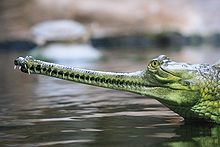Gavialoidea
| Gavialoidea Temporal range: Late Cretaceous - Recent
| |
|---|---|

| |
| Indian gharial, Gavialis gangeticus | |
| Scientific classification | |
| Domain: | Eukaryota |
| Kingdom: | Animalia |
| Phylum: | Chordata |
| Class: | Reptilia |
| Clade: | Archosauromorpha |
| Clade: | Archosauriformes |
| Order: | Crocodilia |
| Clade: | Longirostres |
| Superfamily: | Gavialoidea Hay, 1930 |
Gavialoidea is one of three superfamilies of crocodylians, the other two being Alligatoroidea and Crocodyloidea. Although many extinct species are known, only the gharial Gavialis gangeticus and possibly the False gharial Tomistoma schlegelii are alive today.
Classification
Gavialoidea contains the family Gavialidae and several more basal extinct forms such as Thoracosaurus and Eosuchus. Within Gavialidae are two subfamilies: Gavialidae, which includes the living gharial, and Gryposuchinae, which includes several extinct forms such as Gryposuchus and Aktiogavialis.[1]
In addition to these groups, recent molecular studies suggest that the False gharial and other forms belonging to the crocodylian subfamily Tomistominae may belong to Gavialoidea. As its name suggests, the False gharial is traditionally thought to be only distantly related to the gharial despite its similar appearance. The False gharial and other tomistomines are traditionally classified within the superfamily Crocodyloidea as close relatives of crocodiles. This classification is upheld by morphological evidence, which, when incorporated into phylogenetic analyses, often place the group within Crocodyloidea.[2]
Below is a cladogram from Vélez-Juarbe et al. (2007) showing the phylogenetic relationships of members of Gavialoidea, excluding tomistomines.[1]
| Gavialoidea | |
References
- ^ a b Vélez-Juarbe, Jorge (2007). "A gharial from the Oligocene of Puerto Rico: transoceanic dispersal in the history of a non-marine reptile". Proceedings of the Royal Society B. 274 (1615): 1245–1254. doi:10.1098/rspb.2006.0455. PMC 2176176. PMID 17341454.
{{cite journal}}: Unknown parameter|coauthors=ignored (|author=suggested) (help) - ^ Gatesy, Jorge (2003). "Combined support for wholesale taxic atavism in gavialine crocodylians" (PDF). Systematic Biology. 52 (3): 403–422. doi:10.1080/1063515035019703.
{{cite journal}}: Unknown parameter|coauthors=ignored (|author=suggested) (help)
